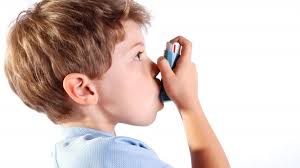Family, Children & Elderly
Asthma in Children
By A.S. (staff writer) , published on August 01, 2020

Medicine Telehealth Health Asthma in children Allergy
Asthma is defined as reversible obstruction of large and small airways of lungs due to hyper-responsiveness to various immunologic and non-immunologic stimuli. Asthma is a chronic inflammatory disorder in which the airways of the lung become tightened and narrowed down making it difficult for breathing.
Asthma is a serious disease causing wheezing, difficulty breathing, and coughing. Over a lifetime, it can cause permanent lung damage. About 16% of black children and 7% of white children have asthma. While we don’t know what causes asthma, we do know how to prevent asthma attacks or at least make them less severe.
If your child has asthma, it’s important to understand their triggers and create a long-term treatment plan to keep the condition managed.
Asthma Triggers
For most children with asthma, there are certain “triggers” that can cause a worsening of symptoms or lead to an asthma attack. Common asthma triggers include:
-
Respiratory infections (viral, mycoplasma)
-
Irritants (air pollution, cold air, cigarette smoke)
-
Ingested allergens
-
Inhaled allergens (dust, pollen etc.)
-
Emotional stress
-
Allergies, especially to animals, dust mites, mold, and other common allergens
-
Physical exercise, especially in cold, dry, or humid weather
-
Changes in weather
Once you know your child’s asthma triggers, you can make a few lifestyle modifications to help your child avoid them as much as possible. Here are several examples:
-
Teaching your child good personal hygiene can lowering their risk of contracting a cold or the flu.
-
If your child has exercise-induced asthma, getting treatment to properly manage their condition can help limit restrictions on playtime.
-
Keeping your house clean of dust, dander, and other allergens can help reduce the risk of allergy-related asthma symptoms.
Symptoms
The most common symptoms of childhood asthma include:
-
Coughing, which becomes worse at night or when your child is sick
-
Wheezing, which can appear as a whistling noise when breathing out
-
Shortness of breath, even when your child is doing normal activities
-
Trouble breathing or fast breathing that causes the skin around the ribs or neck to pull in tightly
-
Frequent colds that settle in the chest
-
Fatigue due to poor sleeping
Causes
The development of childhood asthma can be caused by a variety of factors, including:
-
Infections: Frequent respiratory infections in early childhood
-
Genetic: Having a family history of asthma or allergies has been shown to increase the risk of having asthma.
-
Allergens: substances that trigger your hay fever symptoms, such as pollen, dust mites and pet dander, may also cause asthma signs and symptoms. In some people, skin or food allergies can cause asthma symptoms. This is called allergy-induced asthma
Types of childhood asthma
Recurrent asthma
-
Occurs in early childhood
-
Primarily triggered by common respiratory viral infections
-
Usually resolves during the 4-5 years of life
Chronic asthma
-
It is associated with allergy
-
It persists into later childhood.
Pathophysiology
Asthma is primarily an inflammatory condition of the lungs. Bronchospasm is secondary to inflammation.
Every asthma attack has these pathological components:
-
Brochospasm (bronchoconstriction or smooth muscle contraction)
-
Mucus production
-
Edema and inflammation of the airways mucosa
-
Infiltration of inflammatory cells (eosinophils, neutrophils, basophils, macrophages)
-
Narrowing of the airways
Diagnosis
Diagnosis is mainly clinical:
-
Blood examination: In case of respiratory infection, CBC is helpful. Leucocytosis is common in severe asthma without evidence of bacterial infection. There may be raised level of IgE In the blood.
-
Chest X-ray: Your child’s doctor may choose to perform a chest X-ray to determine if the symptoms are due to conditions other than asthma. Chest X-ray typically won't show if a person has asthma, but can tell if something else (such as pneumonia or a foreign body in the airway) could be causing symptoms similar to asthma.
-
RAST Test: In case of chronic asthma, skin test and radioallergosorbant testing (RAST) are useful in identification of environmental triggers.
- Pulmonary function test. Spirometry test are performed to estimate the lung capacity and lung fuction.
Diagnosis of childhood asthma includes a medical history review and, if necessary, other diagnostic tests. Treatment options for asthma include both short-term and long-term medications and lifestyle changes to help manage the symptoms.
References
- Eleesha Lockett, M. (2020, April 21). Everything You Want to Know About Asthma in Children. Retrieved from HealthLine: https://www.healthline.com/health/asthma/asthma-in-children
- Girish D Sharma, M. (2019, January 8). Pediatric Asthma. Retrieved from Medscape: https://emedicine.medscape.com/article/1000997-overview
- PEDIATRIC ASTHMA. (2019, July 9). Retrieved from American Academy of Allery, Asthma and Immunology: https://www.aaaai.org/conditions-and-treatments/conditions-dictionary/pediatric-asthm
Find articles related to: Medicine Telehealth Health Asthma in children Allergy
More articles about Family, Children & Elderly
Back to the Health Tips Index




